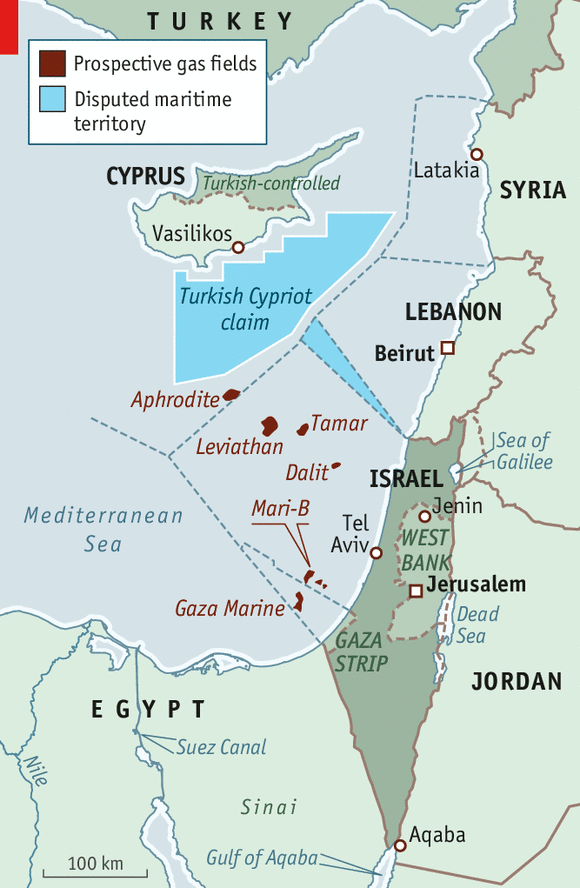
Sharing a common interest in securing offshore mineral exploration areas throughout the Eastern Mediterranean, Israel and Cyprus are tightening defense cooperation through a series of air and naval exercises conducted over the Islands’ southern coast. The relations between Israel, Cyprus and Greece are warming since 2008, as Israel’s close relations with Turkey deteriorated since the rise of Turkish Prime Minister Recep Tayyip Erdoğan to power.

According to Cypriot Defense minister Fotis Fotiou, Cyprus’ relations with Israel are entering a new phase. “I am confident that the strategic dialogue that began several months ago will benefit both countries and will continue on all areas, including energy security.” Fotiou said while visiting a bilateral exercise the Israel Air Force conducted in Cyprus earlier this month, the Cyprus mail reports.
Since the missile crisis in 1998 Cyprus reportedly has bought several types of modern air defense systems from Russia, including the SA-15 Tor M1 and SA-17 Buk SAM systems.
The exercise codenamed ‘Onisilos-Gideon’ was held in Cyprus last week. It took place inside the Nicosia Flight Information Region (FIR), as Israeli fighter jets roared low over Limassol and Chirokitia for several hours. According to sources in Cyprus 32 Israeli fighter jets and six support aircraft took part in the exercise, including F-15 and F-16s. The exercise included simulated firing at targets on land and at sea, along the Island’s southern coast from Limassol to Paphos, the Cypriot side played the air defense role, employing the islands’ air defense systems.

In recent years Cyprus established an impressive air defense network, based on several types of missile systems, primarily Russian made. In 1997 Cyprus acquired an early model of the Russian S-300 air defense system (PMU1). The unit employs 12 mobile launchers, and associated radar and communications units. The entry of that S-300 triggered the missile crisis in 1998 between Cyprus and Turkey, which lead to the transfer of the weapons to Greece. Today the Cypriot S-300 are not based in the island but deployed in Crete under Greek control. In December 2014 the Greek Air Defense forces fired the first S-300 missile during an operational live exercise ‘White eagle’.
A previous exercise held in April 2013 involved the navies of the two nations, operating joint search and rescue (SAR) missions at sea, south of the island. The drills were held in line with the bilateral agreement drawn up in February 2012 between the Cyprus and Israel on SAR issues.
Lacking significant military power, Cyprus has relied on foreign powers to secure the island. In the past, British forces based at Akrotiri provided deterrence against foreign aggression. After the British withdrawal, Greece sent F-16s to be based at a special military annex established at the Paphos International Airport, on the western tip of the island.
“I am confident that the strategic dialogue that began several months ago will benefit both countries and will continue on all areas, including energy security.” Cypriot Defense minister Fotis Fotiou
To support military airpower from abroad the Cypriot government invested in constructing the necessary infrastructure at the Andreus Papandreou Air Base, the primary air base in the island, adjacent to the Paphos International Airport. The military annex has a runway, taxiway, hardened aircraft-shelters and integrated command, control and communication facilities. These facilities were used in the past to host F-16s of the Hellenic Air Force that deployed to Cyprus. Papandreou AFB also houses a small helicopter overhaul and maintenance facility supporting the Cypriot national guard.

In recent years, with the simmering tension with Turkey growing into a conflict over rich offshore reservoirs of oil and gas, Cyprus’ security requirements are growing. In addition, the tension in Syria and potential friction with Lebanese elements also have their effect on the island’s security. One of the most serious incidents happened in September 2013, as two Syrian Sukhoi Su-24 strike fighter jets approached the island from the east. British Royal Air Force (RAF) Typhoon aircraft stationed at the time in Akrotiri were scrambled against the Syrian fighters, which turned back before entering the aerial exclusion zone around the base. The British jets were part of a combined force sent by NATO to prepare to assist civilian relief operations following the chemical attacks against civilians in Syria.
In addition to joint exercises Israel has also applied to Cyprus in a request to establish an operational support site in Paphos. RIEAS reports. In addition to supporting military jets during exercises over the mediterranean, the site could be used to support patrol aircraft and helicopters operating on maritime surveillance flights over the Israeli and Cypriot Aphrodite and Leviathan exploration areas located mid-way between Cyprus and Israel.
Offshore exploration areas patrolled by the IAF are located within the Israeli Economical Exclusion Zone (EEZ) spanning up to 200 miles from the israeli coastline and adjacent to the Cypriot EEZ. Aircraft patrolling these areas could benefit from a landing base in Cyprus in case of emergency, or when required to maintain persistent surveillance over remote areas. Israel is operating on maritime patrol missions the Sea-Scan maritime patrol aircraft, S-365 Dolphin helicopters helicopters and Heron-I unmanned aerial vehicles.


















